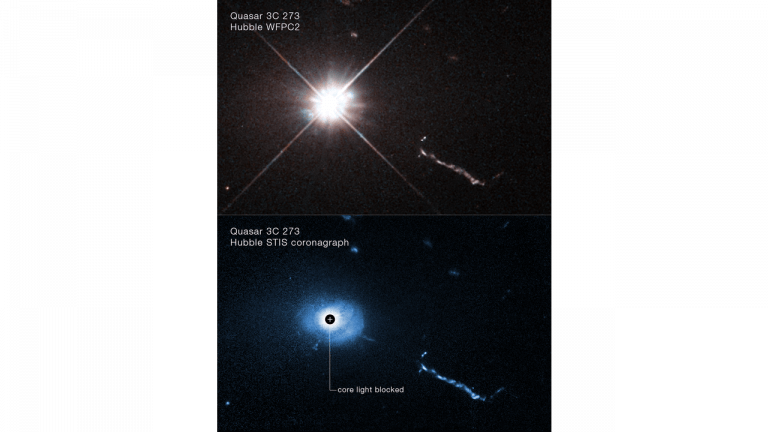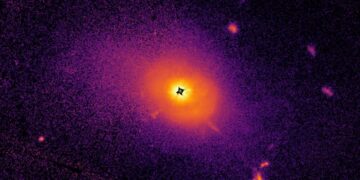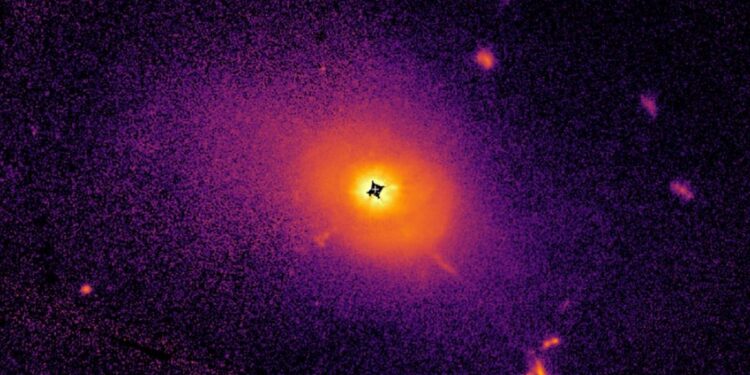The universe is full of enigmatic wonders, and quasars stand out as some of its most fascinating entities. Among them, 3C 273 holds a special place as the first quasar ever identified. Recent observations by the Hubble Space Telescope have provided the clearest and most detailed view of this iconic quasar yet, uncovering intriguing features that enhance our understanding of these cosmic powerhouses.
What Makes Quasars So Special?
Quasars, or quasi-stellar objects, are among the brightest and most energetic phenomena in the universe. These luminous objects are powered by supermassive black holes (SMBHs) at the centers of galaxies. As gas, dust, and other material spiral into the black hole’s accretion disk, intense heat is generated, releasing vast amounts of electromagnetic radiation. This process makes quasars visible across billions of light-years, often outshining their host galaxies.
3C 273 is a prime example of this phenomenon. Discovered in 1963 by astronomer Maarten Schmidt, it became the first quasar linked to a visible object. Located approximately 2.5 billion light-years away, 3C 273 is so luminous that it can be observed with amateur telescopes, making it a benchmark for quasar studies.
Unveiling the Secrets of 3C 273
Despite its brightness, studying 3C 273 has always been challenging due to the overwhelming glare it emits. However, the Hubble Space Telescope has overcome this obstacle using its Space Telescope Imaging Spectrograph (STIS) equipped with a coronagraph. By blocking the quasar’s blinding light, the coronagraph allowed astronomers to observe the region around the quasar in unprecedented detail.

This technique revealed a wealth of new features, including:
- Core Jet and Blobs: The discovery of a core jet and several smaller blobs near the black hole provided fresh insights into the dynamics of material being accreted and ejected.
- Filamentary Structures: Mysterious L-shaped filaments and lobes were observed, likely resulting from the interaction between the quasar’s jets and its surrounding interstellar medium.
These findings, published in the journal Astronomy and Astrophysics, mark a significant advancement in quasar research. Lead author Bin Ren emphasized that these observations bridge the gap between small-scale radio studies and large-scale optical imaging, offering a more comprehensive understanding of quasar morphology.
The Role of Active Galactic Nuclei Feedback
One of the most fascinating aspects of quasars is their impact on their host galaxies. This influence, known as Active Galactic Nuclei (AGN) feedback, involves the interaction between the quasar’s energy output and the surrounding gaseous medium. In the case of 3C 273, the newly observed filaments are thought to be gas condensing from the intergalactic medium, potentially fueling further AGN activity.
AGN feedback plays a critical role in regulating star formation within galaxies. The energy released by the quasar can either stimulate or suppress star formation, depending on the circumstances.
Unraveling Jet Dynamics
A striking feature of 3C 273 is its extragalactic jet—a high-energy beam of particles extending approximately 300,000 light-years from the quasar. This jet is one of the longest ever observed and provides a unique opportunity to study the physics of jet formation and acceleration.
By comparing Hubble’s recent observations with archival data from 22 years ago, researchers discovered that the jet’s speed increases with distance from the black hole. This counterintuitive finding challenges existing models of jet dynamics and suggests that additional forces may be at play, such as interactions with the surrounding medium or magnetic field effects.
How Hubble’s Observations Bridge the Gap
Hubble’s ability to capture detailed images of 3C 273 has bridged a crucial gap in astronomical research. Previously, small-scale features of quasars could only be studied using radio interferometry, while large-scale structures were observed through optical imaging. Hubble’s STIS coronagraph has unified these approaches, providing a holistic view of 3C 273’s complex environment.
This breakthrough underscores the importance of technological advancements in astronomy. As telescopes like the James Webb Space Telescope (JWST) come online, researchers can delve even deeper into the mysteries of quasars, exploring their structures in infrared wavelengths to uncover new layers of information.
Looking Ahead: The Future of Quasar Research
While Hubble’s observations of 3C 273 are groundbreaking, they are just the beginning. The James Webb Space Telescope, with its advanced infrared capabilities, promises to unveil even more about this iconic quasar. Infrared observations can penetrate the dust and gas obscuring the quasar’s core, providing a clearer view of its inner workings.
Moreover, future telescopes like the Extremely Large Telescope (ELT) and the Square Kilometre Array (SKA) will enable astronomers to study quasars with unprecedented precision. These instruments will not only enhance our understanding of 3C 273 but also uncover new quasars, further expanding our knowledge of these extraordinary objects.
Conclusion
Hubble’s latest observations of quasar 3C 273 mark a milestone in our quest to understand the universe. By unveiling intricate details of this luminous object, astronomers have gained new insights into the dynamics of supermassive black holes, the impact of AGN feedback, and the physics of extragalactic jets. These discoveries not only deepen our understanding of quasars but also pave the way for future research, promising even more revelations about the cosmos.
Reference:



















